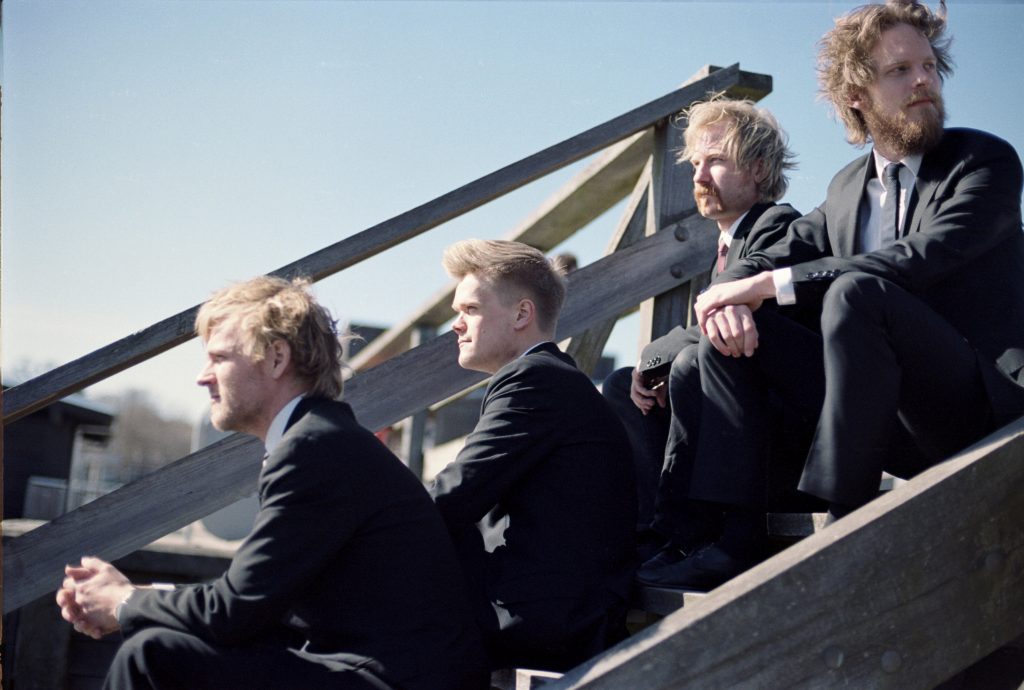The Danish String Quartet Excels with Its Three B’s: Bach, Beethoven, and Bartók
The Danish String Quartet invited Friday’s audience at The Conrad to join them on the third musical journey of their “Prism Project,” their exciting current residency at the La Jolla Music Society. Starting with the serene counterpoint of J.S. Bach, the quartet seamlessly moved to Beethoven’s bold thematic freedom and culminated with Bartók’s heady release from the predictable straitjacket of tonality.

The Danish String Quartet [photo (c.) Caroline Bittencourt]
In western music, the vocabulary of musical style may ebb and flow, but the grammar of its musical infrastructure remains.
By the end of the 17th century, the ability to improvise fugues at the keyboard was a required skill for organists in German Lutheran churches. Dietrich Buxtehude’s multi-sectional praeludiums frequently contain two fugues on contrasting subjects, and the young J. S. Bach—as every music history student learns—walked across Germany to study with Buxtehude in that great Hanseatic city of Lübeck.
Bach expanded and deepened the scope of the fugue, ennobling it in both his monumental The Art of Fugue and the two volumes of The Well-Tempered Clavier, wherein he constructs formidable fugues in every major and minor key, a practice that has inspired composers as opposite as Chopin and Shostakovich to undertake similar compositional feats. Beethoven had access to the costly—in that era—published copies of all of Bach’s contrapuntal works in the substantial library of his patron Archduke Rudolph. In addition, Beethoven included carefully notated themes of Bach’s music in his musical sketchbook, from which his own compositions arose.
The Danish String Quartet opened this concert with Bach’s Fugue No. 4 in C-sharp Minor from the first volume of The Well-Tempered Clavier, imbuing it with a glowing serenity that beguiled listeners in spite of its calculated dynamic understatement. Bach’s fugue slyly set up Beethoven’s String Quartet in C-sharp Minor, Op. 131, which commences with an understated fugue in its opening Adagio movement. Violinists Frederik Øland and Rune Tonsgaard Sørenson introduced that fugue as if it were a mystical incantation to which violist Asbjørn Nørgaard and cellist Fredrik Schøyen Sjölin could only add their awed assent.
In Op. 131’s glorious center movement—for this string quartet, Beethoven devised a deftly balanced seven-movement arch form—he again presents the main theme as a dulcet conversation between the violins that quickly expands into a set of complex yet inviting variations. Delicate elaborations are rudely interrupted by vibrant pizzicatos or playing on the bridge, Beethoven’s anticipation of the late 20th-century’s fascination with extended instrumental techniques. The Danish String Quartet seamlessly integrated these contrasting requirements into a sumptuous tapestry, and violinist Øland offered a stunning cadenza-like flourish at the movement’s final cadence.
The ensemble excelled communicating the major-mode exuberance of the Allegro molto vivace, and their Presto suggested a sense of abandon without compromising their technical finesse. The final movement arrived with a joyful sense of completion, reminding us how much the rich, luxurious timbres of violist Nørgaard and cellist Sjölin and the silvery sounds of the violins fused into a rapturous sonority that can only be described as dangerously addictive.
In 1909, when Béla Bartók wrote his First String Quartet, he had already spent several years researching and transcribing the authentic folk music of central Europe, music quite untouched by Europe’s traditional classical music. The unusual modes and asymmetrical rhythms of this strange but enticing music characterize his String Quartet No. 1, and the Danish String Quartet boldly brought us into Bartók’s brave new world. They wisely chose a stronger, darker color for his rugged ensemble sections, yet their immaculate ensemble was never threatened.
Bartók gave the cello a welcome dominant role his first movement and a fine cadenza in the last movement; in each case, Sjölin’s command blossomed with welcome vigor. String quartets tend to program Bartók’s later string quartets, so it was particularly rewarding to hear the First String Quartet played with such mastery.
This concert was presented by the La Jolla Music Society on November 22, 2019, in the Baker-Baum Concert Hall at the Conrad Prebys Performing Arts Center in downtown La Jolla. The final two concerts of the Danish String Quartet’s residency will be presented in this venue at 3:00 p.m. and 8:00 p.m. November 23.

Ken Herman, a classically trained pianist and organist, has covered music for the San Diego Union, the Los Angeles Times’ San Diego Edition, and for sandiego.com. He has won numerous awards, including first place for Live Performance and Opera Reviews in the 2017, the 2018, and the 2019 Excellence in Journalism Awards competition held by the San Diego Press Club. A Chicago native, he came to San Diego to pursue a graduate degree and stayed.Read more…
